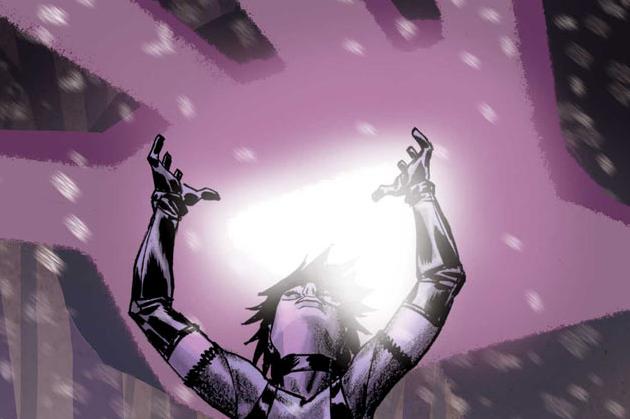Avengers Arena #10
Writing credits: Dennis Hopeless.
Art credits: Riccardo Burchielli (interior), Dave Johnson (cover), Jean-Francois Beaulieu.
Curse you, Dennis Hopeless. Ten issues in, and we’re past the midway point of the “Game On” story arc. A quarter of the sixteen prisoners on Arcade’s new Murder World have been killed (possibly one more - Darkhawk’s fate is still up in the air.) This story is really starting to pick up, and the tension is starting to build. I can’t say I have a deep emotional attachment to many of the characters, as they are a majority of C-tier heroes (with the exception of Laura/X-23). This hasn’t stopped me from being intrigued by the concept of the story and how they handle themselves in the face of true danger.
Issue 10 opens with the cliche foreboding scene of a gravely injured character, then skips back in time to tell the reader how they came to be in that situation. The character in question is the Runaways’ Nico Minoru. I’ve never been a fan of this approach to story-telling. I’m not a fan when television programs use it, and I’m not a fan when comics use it. Despite the bad taste in my mouth from the opening, I quickly forgot about it as we got into the whys of the situation. I’ve been a fan of the Runaways since Brian K. Vaughn’s first arc, so I’m probably most emotionally attached to Nico and Chase of all prisoners. Seeing her beat to hell was hard to see.
The gravity of the situation is really becoming clear to me. There have been a lot of “certain death” scenarios in comics, but this series is beginning to deliver on those threats to the characters. It’s not secret that this series is heavily inspired by Battle Royale, it was explicitly said so in the earlier flashback issue that featured Arcade’s motives behind creating this situation, and Avengers Arena is taking cues from the source material and keeping things bloody and violent. What we haven’t touched too deeply on is how or why he chose certain characters to include in his depraved tribute to Battle Royale. I hope this is something that becomes clear further on down the line.
As a fan of a number of the characters, I do feel somewhat let down that their ultimate demise comes in these pages, not those of their own series. I was really torn up in the first issue at Mettle’s sudden death. I really enjoyed the Avengers Academy run and loved the dynamic between him and Hazmat. As the cast is starting to dwindle down, we’re getting to spend more time with each character. This was an issue I had in the beginning, as there were a lot of stories that needed to be crammed into the book. Now that Hopeless has pared the cast down, we get more of a focus on their individual situations. The reveal of Apex’s personality issues was great earlier in this arc, and she’s emerged as a real threat to the obvious forerunner for survivor, X-23.
I love Burchielli’s work here. He excels at presenting these situations to the reader. The images of a broken Nico were quite powerful. It’s hard to show so many characters in a truncated space, as he does during the sentinel chase scene towards the climax of this issue. At the same time, he managed to show how boxed in the heroes were despite the open-nature of Murder World. The story can only build so much tens ion, it relies on the art to echo those sentiments. It’s obvious that Burchielli and Hopeless are on the same page here.
I generally don’t spend much time reading the letters in the back of issues, but I was treated to an intriguing reveal in this column. Issue 13 will be the second break from the action on Murder World and focus on the outside world. I’m looking forward to the penultimate issue of Game On, and what else Hopeless has in store for us.





